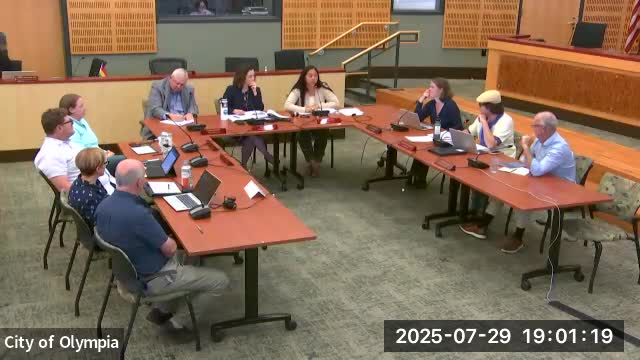Council Member Gilman Advocates for Fair Impact Fees on New Developments
July 29, 2025 | Olympia, Thurston County, Washington
This article was created by AI summarizing key points discussed. AI makes mistakes, so for full details and context, please refer to the video of the full meeting. Please report any errors so we can fix them. Report an error »

In the heart of Olympia's city hall, council members gathered for a study session that sparked a lively debate on the future of urban development and transportation. The atmosphere was charged as Council Member Gilman raised concerns about the fairness of passing development costs onto households, suggesting that it could be a regressive approach. “It feels like backwards land to me,” he remarked, questioning the equity of subsidizing new developments at the expense of existing residents.
The discussion quickly expanded as Council Member Madrone chimed in, emphasizing that impact fees are not solely related to transportation but also encompass parks and schools. He pointed out that prior to the Growth Management Act (GMA), there were no impact fees at all, raising questions about the historical context of equity in development costs. “I think there’s a broader conversation to have on this,” he stated, suggesting that the topic might be too complex for the current chapter of discussion.
As the conversation shifted, Council Member Brandapol interjected, noting that a vote had not yet taken place, indicating that the council was still in deliberation. The dialogue then turned to the specifics of transportation planning, particularly the implications of street widths. Concerns were raised about the practicality of five-lane streets in a multimodal city, with one member expressing that such designs prioritize automotive travel over other forms of transportation, creating an imbalance in the hierarchy of urban needs.
In response, a proposal was highlighted to retrofit existing major streets to be more human-scale, including a study to potentially reduce five-lane streets to three lanes. This initiative aims to prioritize pedestrian and cyclist safety, reflecting a shift towards more inclusive urban planning.
As the session drew to a close, it was clear that the council's discussions would have lasting implications for Olympia's development strategy. The balance between accommodating growth and ensuring equitable costs for residents remains a pivotal challenge for the city, setting the stage for future conversations on how to create a more inclusive and sustainable urban environment.
The discussion quickly expanded as Council Member Madrone chimed in, emphasizing that impact fees are not solely related to transportation but also encompass parks and schools. He pointed out that prior to the Growth Management Act (GMA), there were no impact fees at all, raising questions about the historical context of equity in development costs. “I think there’s a broader conversation to have on this,” he stated, suggesting that the topic might be too complex for the current chapter of discussion.
As the conversation shifted, Council Member Brandapol interjected, noting that a vote had not yet taken place, indicating that the council was still in deliberation. The dialogue then turned to the specifics of transportation planning, particularly the implications of street widths. Concerns were raised about the practicality of five-lane streets in a multimodal city, with one member expressing that such designs prioritize automotive travel over other forms of transportation, creating an imbalance in the hierarchy of urban needs.
In response, a proposal was highlighted to retrofit existing major streets to be more human-scale, including a study to potentially reduce five-lane streets to three lanes. This initiative aims to prioritize pedestrian and cyclist safety, reflecting a shift towards more inclusive urban planning.
As the session drew to a close, it was clear that the council's discussions would have lasting implications for Olympia's development strategy. The balance between accommodating growth and ensuring equitable costs for residents remains a pivotal challenge for the city, setting the stage for future conversations on how to create a more inclusive and sustainable urban environment.
View full meeting
This article is based on a recent meeting—watch the full video and explore the complete transcript for deeper insights into the discussion.
View full meeting
